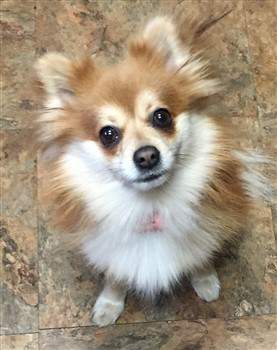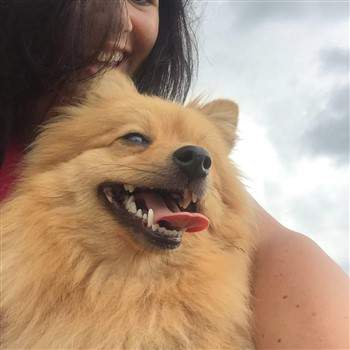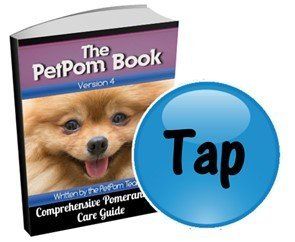Pomeranian First Aid
Kits, Cuts, Stings, Pain, Fever, Poisoning & Toxins, Choking, and Being Hit By a Car
Overview
Normally, you’ll want to bring your Pom to the vet should something happen that requires first aid. However, there are several instances when this will not be immediately possible.
Just one example is if you are off the beaten path (perhaps out on a hike, camping in the woods or otherwise not able to reach your car and/or the vet’s office right away).
There may also be times that your Pomeranian’s vet office is closed and treating your dog at home is possible… if you know what to do.
Other times, there may be an emergency situation that requires you to act quickly.
For these reasons, this section will cover some of the most common first aid that may need to be done on a Pomeranian puppy or dog. We will cover:
- The essentials you should have on hand in a small first aid kit for your Pomeranian
- How to treat a cut
- Treating a bee sting
- Treatment of minor pain and/or a fever from home
- Poisoning and exposure to toxins
- What to do if your Pomeranian stops breathing or is choking
- What to do if your Pom is hit by a car
Putting Together a Small Yet Important First Aid Kit
Not everyone has a first aid kit for themselves, let alone their pets. So do you really need one for your Pomeranian? Having a few things put together is the wise move; it can save you the stress of running around looking for things, get your Pomeranian immediate help and in some cases, it can even save his life.
Also, if you’re traveling or heading out on an excursion with your dog, it’s a good idea to bring the kit along with you. You never know and it’s really best to prepare. No worries, the kit is rather small and easy to tuck into your travel bag.
What you should have:
1. Betadine Solution
- This is for washing out cuts. It is a fast-acting, broad-spectrum antiseptic to clean wounds and reduce bacteria that can cause serious infection. Do NOT use soap (not effective), rubbing alcohol (can damage skin
tissue) or hydrogen peroxide (best to use only if an infection has set in).
2. Gauze pads
- Sterile gauze pads can be used for a number of purposes. For some injuries and cuts, betadine (see above) can be poured over the injury (or use a syringe - see ahead) and then using some gauze pads, dab at the edges of the wound. These are also used to apply pressure to a wound that is actively bleeding. You’ll want to apply pressure, stopping every 10 minutes to see if the bleeding has stopped.
3. Paw bandages
- While a cut is healing or when transporting your Pomeranian to the veterinarian, it’s important to keep the site clean. If a Pomeranian receives a nasty cut or injury to one of his paws, you’ll find it really hard to wrap it up without these. These disposable type bandages slip over the paw and are secured via a Velcro piece that wraps around the ankle.

Bella at 2 years old
Photo courtesy of Kathy Bradley
4. Canine rectal thermometer
- It’s really important to have one of these to properly take your Pomeranian’s temperature. You’ll need to do this if there is question of heat stroke or fever. If your Pom is not feeling well, you’ll want to be able to let the vet know about any high temperature while you are calling to discuss the issue or make an appointment. We highly recommend one with a flexible rubber tip and a quick, digital readout. The normal body temperature for all puppies and dogs is between 101 to 102.5 degrees Fahrenheit.
5. Petroleum jelly
- You’ll want to have this to use in conjunction with the thermometer. When you take your Pomeranian’s temperature, use this to lubricate the thermometer, which is then inserted into the anus 1/2 inch for puppies and about 1 inch for adult Pomeranians.
6. Hydrogen Peroxide
– This may very well save your Pom’s life. In case of poisoning, you may be instructed to immediately induce vomiting. Giving this depends on what it is that a dog ingested; with some toxins more damage can occur if the dog throws up and with others, it can be lifesaving.
If you are instructed to induce vomiting, one of the most effective methods is to give the dog hydrogen peroxide. Check with your vet; however, the typical dose is 1 teaspoon for each 5 pounds of body weight with another dose given after 10 minutes if the dog does not vomit.

Catalina, at 2 and 1/2 years old
Photo courtesy of Karla
7. Activated charcoal tablets
- This can be used to absorb toxins and again, it is dependent on what was ingested. If your Pomeranian is poisoned, you should call the vet ASAP for instructions. It is best to have both this and the hydrogen peroxide so that you can be ready no matter what the instructions.
8. Medicine syringe
– You may already have one of these at your house if your Pom already takes or has taken liquid medicine as most are packaged along with a syringe. If you do not have a syringe, it’s time to obtain one. In an emergency situation, if you need to get your Pomeranian to swallow hydrogen peroxide, using a medicine syringe is just about the most effective method. You will pull your dog’s cheek out to form a small pocket and shoot the liquid between the cheek and the teeth, closing the mouth immediately afterward.
9. Thermal blanket
– Small when folded, light and easy to transport, this is a life-saving item. If your Pomeranian is severely injured (hit by a car, etc.), wrapping him in a thermal blanket can stop him from going into shock while you transport him to the animal hospital.
10. Eye wash
- This is needed to flush a dog’s eyes of any contaminants if such an event occurs.
If you are alone with your Pomeranian, it is best done by holding the bottle above the dog’s head (where he cannot see it) and letting the drops drip down into the eye. If there is someone there to assist you, that person can hold the bottom lid out a bit, and drops are put into the pocket of the bottom lid.
Tip
- Please note that the eye wash is completely different products than eye tear staining liquid or any type of cleaner like that. Those are grooming
items and this is a first aid item formulated to clean and flush the eyes.
11. Artificial tears
- If you have to flush out your Pomeranian’s eyes, canine artificial tears can help soothe them afterward if they appear irritated.
12. Benadryl
– For allergic reaction, including minor to moderate reaction to venomous insects (severe reaction requires immediate vet care), plain liquid Benadryl is something you’ll want to have on hand.
13. Baking soda
– Needed to treat insect stings, helps to stop pain and reduce swelling.
14. Antibacterial ointment
– For the ongoing treatment of cuts and scrapes.
How to Treat a Cut on a Pomeranian
- Maybe your Pom make a quick turn around a corner and got a cut on his side. Or maybe your dog stepped onto something sharp that cut the paw. Either way, there is a slice to the skin and it’s bleeding. What do you do?
1. Apply pressure to stop the blood. It’s best to use sterile gauze pads. Do this for about 10 minutes, then check. During those 10 minutes, if the blood goes through the gauze, don’t lift it off, just add more. If it’s still bleeding when you check it, do another 10 minutes. If blood is still flowing after that, the cut most likely needs to stitched by the vet.
2. Once the bleeding has stopped, gently flush the cut using betadine mixed with water (until it is watered down to look like the color of iced tea) and a plastic syringe. If you don’t have this, you can dab it (not wipe) with gauze pads and betadine.
3. Apply a thin strip of antibacterial ointment. If the cut is on an area that the Pomeranian can lick, it is best if this is reapplied each night, just as the puppy or dog has fallen asleep. If the cut is on the paw, use a paw bandage to keep your Pom from licking
at it and to keep it clean.
4. If it oozes any pus, if the skin is raised or red or if it is not showing any signs of healing after 3 days, you’ll want the vet to take a look. It may need to be butterfly bandaged, it may need stitches and/or medication for infection may need to be given.
Tip – Moderate to deep puncture wounds (such as getting bit by a dog, stepping on a nail, etc.) need to be treated by the vet. For these, keep a damp compress on the injury as your dog is being brought to the vet; the goal is to delay the formation of any scabbing which can lock infection under the skin.
How to Treat a Bee, Wasp, Hornet or Yellow Jacket Sting - We have a full, detailed section regarding how to prevent and treat bees stings to a Pomeranian, so this section will be a very brief summary.
1)
Be sure that all stingers have been properly removed by scraping them out.
2)
Clean the injection site on your Pomeranian with warm water and soap to remove body oils that may impede further treatment.
3)
Use a mix of baking soda and water, mixed to a paste, for bee and yellow jacket stings. Using a gauze pad, apply for 15 minutes. Repeat if your Pom shows signs of discomfort or if the area is very red.
Use the above baking soda for wasps or hornet stings OR gauze pads soaked in vinegar for wasp or hornet stings.
4)Once this is done, it can help to apply a small ice pack to help with the swelling.

Rocco, at 2 years old
Photo courtesy of Lena
5)
For slight itching and slight allergic reaction, Benadryl may be given. Check with your vet first. Recommended dosing is 1 mg/ for each pound of body weight, given every 8 hours; but can be doubled to 2mg for each pound of body weight, if needed. Note:
Most liquid formulations of Benadryl will have a concentration listed on them, usually 5 mg per teaspoon, so be sure to read the label before giving any to your puppy or dog.
For moderate to severe allergic reaction, MUST be treated at the veterinarians where a powerful drug such as epinephrine may need to be used. It can take 45 minutes for symptoms to develop, so do not leave your Pomeranian home alone
after an incident with bees. Signs are swelling (at the site, on the face, around the mouth or around the eyes), weakness, trouble breathing, rash, vomiting, pale gums, cold limbs and/or drooling.

Prince Fluffy at 7 weeks
Photo courtesy of Sandra Vasiu from Austria, Carinthia
Treating Minor Pain or a Fever
- Your Pom may have a slight fever or minor pain that you wish to treat at home. It is still recommended to call the vet for proper care instructions. The veterinarian may very well instruct you to treat this at home and keep an eye on things. Alternatively, there may be times when you cannot reach the vet and feel that you should treat your Pom promptly. In these cases, it is important to know which medicines can be given to a Pomeranian and which would be very harmful.
Do NOT GIVE:
X
Advil or Motrin (brand names) ibuprofen (generic name) – is toxic to dogs
X
Aleve (brand name) naproxen (generic name)- is toxic to dogs
X
Tylenol (brand name) acetaminophen (generic name) – can be given when supervised by a vet, but can be dangerous.
YOU CAN GIVE:
Buffered Aspirin – This is typically considered safe for canines, however strict dosing instructions need to be followed, since this is a NSAID that can cause sometimes quite severe issues.
The element that makes Aspirin safer for dogs is that with Buffered Aspirin, there is a layer of protection via a coating that can help prevent the stomach lining and intestines from the harmful effects of the NSAID ingredient.
This is sometimes given to dogs for short term use only, which would be no more than 1 week (long term use can cause damage to cartilage and internal bleeding). While there are better options of medications formulated just for canines, this is sometimes given for acute cases of low grade fever or mild pain that is not expected to last more than one week.
Dosing
- Dosing is based on the dog's weight. For adult Pomeranians, proper dosing is 5 to 10 mg for each pound of body weight, given once every 12 hours. It is best to start off of the lower side of that and only go up to 10 mg/lb. of body weight if needed. For Pomeranian puppies, due to slower function of both the liver and kidneys, dosing is often lower, no more than the 5 mg and sometimes less.
Side Effects
- Even though you can give coated Aspirin to a Pomeranian in low doses and for a short amount of time (no more than 7 days), there are some possible side effects to look out for. This includes stomach upset, diarrhea
and/or vomiting. If your Pomeranian shows any of these signs, you will want to stop giving the Buffered Aspirin to him and contact the veterinarian.
Poisoning and Exposure to Toxins
Ingested Toxins
- The list of things that are toxic to dogs includes literally countless elements that are also toxic to humans, along with:
- Alcohol
- Caffeine (any food/drink with caffeine)
- Cherries
- Chocolate
- Currents
- Garlic (a bit of garlic powder is not toxic; pieces of garlic are)
- Grapes – One of the most toxic foods in the world for canines. Very poisonous and can be fatal.
- Grapefruit
- Mushrooms (not all types; but it is better to be safe than sorry)
- Onions
- Potatoes (when raw or green)
- Raisins – Like grapes can be fatal if eaten.
- Rhubarb
- The seeds/core of MANY fruits
Note:
There are so many other things that can be toxic to a dog; if you are even in doubt, call your vet.
What to do:
If you know your Pomeranian has ingested something that may be harmful, or your dog is showing signs of poisoning such as seizures, drooling or trouble breathing, call the vet ASAP. Do not delay. Depending on what may have been ingested, you may be instructed to induce vomiting (by giving the dog hydrogen peroxide; 1 teaspoon for each 5 pounds of body weight with another dose given after 10 minutes if the dog does not vomit), give him milk, give activated charcoal OR rush him to the clinic.
Note:
If your Pomeranian has vomited, bring as large of a sample as possible with you to the clinic.
You may also want to phone the Animal Poison Control Center hotline (888.426.4435 – available 365 days/year, 24 hours/day) or the or the Pet Poison Helpline at 1-855-213-6680. Do keep in mind that there is a fee for both of these.
Chemical Exposure
– This would be any airborne chemical that the Pomeranian inhaled or any chemical that the dog touched. This includes but is not limited to cleaning products, poison for rodent control, pesticides and anti-freeze.

Latte, at 1 year old
Photo courtesy of Ekachai Chuchuen and Norman Allin, Bangkok Thailand
If Skin is Exposed to a Chemical
– Read the label and follow the instructions; in many cases you will flush with water.
If a Chemical Has Been Inhaled – Bring your dog outside, if possible, for fresh air. Then, call the vet or the Animal Poison Control Center hotline (888.426.4435 – available 365 days/year, 24 hours/day) or the or the Pet Poison Helpline at 1-855-213-6680. Do keep in mind that there is a fee for both of these.
If a Dog Has Stopped Breathing/ Is Choking - If a dog is choking, rarely is there time to call the vet or bring him there. Quick action must be taken by the owner. This said, it is important to note that these life-saving techniques should only be performed on a dog that is truly choking, not just coughing, overheating, etc. A dog that is truly choking will struggle to inhale. Signs of chocking on a foreign object include: extreme distress, pawing at the mouth or rubbing the face upon the ground, continuous gagging/retching and increased salivation. If a dog is not able to take in any air at all, there will be a bluish to red-purple tinge of the tissues, seen best in the gums and skin (known as cyanosis).
1)
Stay calm. If you panic, it will be very hard to follow through with what you need to do.
2)
If possible, have another person call the veterinarian while you help your dog.
3) You will need to open the airway. This is done by gently pulling the tongue out of the mouth until it is flat. If you are able, look to see if you can spot any foreign objects in the mouth or the back of the throat.
4)
If you DO see an object, try to remove it with a tweezers or tiny pliers. Do not spend a lot of time doing this; 30 seconds at the most.
5) If you do see an object but cannot remove it, place your Pomeranian in your lap, with his back to you. Place both hands on the sides of his ribcage. Apply a quick, firm pressure 3 times in a row. If this does not work, lie your Pomeranian down and using the palm of your hand, strike the rib cage firmly 3 times.
6) If you do not see an object OR if your Pomeranian is not breathing (and you do not know why), perform CPR rescue breathing. If you have someone with you, do this on route to the closest animal hospital. This is done by closing the dog’s mouth with your hand and breathing directly into the dog’s nose. The chest should expand outward when you do this. Perform every 4 seconds (count out ‘one Mississippi, two Mississippi, etc.) until you arrive at the clinic.

4 incredibly cute Pomeranian pups
Photo courtesy of Sam
What to Do if Your Pomeranian is Hit by a Car
- Trauma is the 1st leading cause of death for all puppies of any breed and is the 2nd leading cause of death for the Pomeranian breed. Of course, making sure that your Pom is always on harness and leash
and taking steps to prevent him from escaping from the house are two effective methods to prevent terrible accidents. This said, all sorts of random situations can occur that, sadly, leads to a Pomeranian being hit or run over by a car.
You’ll need to act quickly, yet do you best to remain calm.
It is important to note that, ambulances will not come to help a dog that is hit by a car or otherwise severely injured; you will need to transport your Pom to the closest animal hospital.
Here are the steps to take:
1. Move your Pomeranian to a safe location
to assess him and get him out of any danger of other cars. This is best done by using an appropriately sized blanket, and of course, this is best if you have a helper or two. The blanket should be used as a sort of stretcher.
2. Check to see if your dog is breathing.
If not, perform CPR as described in the previous section.
3. Any wounds that are bleeding
should be covered with a cloth and pressure should be applied.
4. Help prevent shock.
Many dogs that are seriously injured will enter into hypovolemic shock due to significant blood loss. Now is the time to use the small thermal blanket that we talked about earlier under things to have in your first aid kit. If you do not have one, another towel or even a jacket or other clothing can be placed over and around the dog (not too tight against injuries).
5. Since help will not come to you, you must get your Pomeranian to the closest animal hospital or vet ASAP. Your instinct will be to call 911 and while you may want to do this to report the driver that hit your dog, an ambulance will not assist your dog. If he is not already on a blanket (from when you moved him away from danger), use a blanket (other options are a towel or even a piece of cardboard if nothing else is available), as a sort of stretcher, place him in the car. This should be kept under a dog during transport so that he can be removed from the vehicle in the same way.
Note:
Since your job is to rush your dog to receive help, do not take time to clean wounds (this should be done at the vet’s in a sterile environment) or wrap tourniquets (these are dangerous and can increase the risk of tissue damage or even the loss of a limb; tourniquets should only be used if a limb has been lost). If a limb has been lost, use a 2-inch piece of cloth. Wrap this around the limb 2 times and knot it. Use a small stick (even a pen can work) that is then slipped into the knot. Use the stick to tighten the tourniquet to stem the blood flow. Take careful note of the time. The tourniquet should be released every 20 minutes for 20 seconds.

What is your Pom's animal sign? And what does that mean?
Have fun in our newest section, Pomeranian Chinese Zodiacs.
See how your Pom's year of birth can give you insight into his/her core personality & traits.
Things to Do Now:
Become a Free PetPom Member
(if you are not already a Member) so that you'll receive a friendly reminder when we add a new Topic of the Month to this Pomeranian blog & when we add new pages and sections to the site! You will also receive a fun & helpful Welcome Booklet.
You asked & we delivered!
See what's in the BIGGER, BETTER, PRINT EDITION of the PetPom Book.


